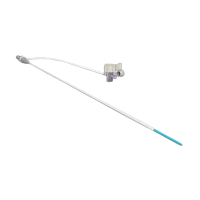Medical technology has made significant advances in recent years, leading to the development of innovative tools and techniques in the field of interventional surgery. One such breakthrough instrument was the introducer sheath catheter, which revolutionized the way minimally invasive surgery was performed. Barty Medical Technology introducing sheath catheters usually consist of a catheter and a sheath. A catheter is a hollow, tubular structure used to guide and position instruments. A sheath is a tubular structure that fits over the outside of a catheter to stabilize it and reduce friction.

What is an introducer sheath catheter
An introducer sheath catheter is a specialized medical device designed to facilitate the insertion and navigation of other instruments during interventional procedures. It consists of a flexible tube with a hollow lumen that allows the passage of various tools, such as guidewires, balloons, stents, or other catheters. The outer surface of the introducer sheath catheter is usually smooth and lubricated to minimize friction during insertion.
Applications in interventional surgery
Coronary intervention
In the field of cardiology, introducer sheath catheter are widely used in coronary intervention procedures such as angioplasty and stent placement. These procedures involve inserting a catheter through an introducing sheath and then advancing the catheter to the desired location within the coronary arteries. The introducer sheath catheter provides stability and support, allowing for precise stent placement or delivery of therapeutic agents.
Neurovascular intervention
Introducer sheath catheter also play a crucial role in neurovascular interventional treatments, particularly in the treatment of cerebral aneurysms and arteriovenous malformations (avms). By providing a stable platform, these catheters facilitate the passage of microcatheters and guidewires through complex vascular structures, ensuring accurate placement of embolic agents or coils.
Peripheral vascular intervention
In peripheral vascular interventions, such as the treatment of peripheral arterial disease (pad), introducer sheath catheter assist in the delivery of balloons, stents, or plaque removal devices to the affected vessel. The sheath provides support and helps keep blood vessels open during the procedure, thereby increasing the overall success rate.
Advantages of Introducing Sheath Catheters
Improve accuracy
The design of the introducer sheath catheter allows precise navigation and placement of various interventional tools, ensuring accurate delivery of treatment to the target site. This increases the success rate of the procedure and reduces the risk of complications.
Minimally invasive method
By utilizing a introducer sheath catheter, interventional procedures can be performed through smaller incisions or access points, minimizing patient discomfort, scarring, and recovery time.
Enhance security
The use of a introducer sheath catheter improves stability and control during interventional procedures, thereby reducing the risk of vascular injury or perforation. This enhances patient safety and improves overall surgical outcomes.
Conclusion
The emergence of introducer sheath catheter has greatly changed the landscape of interventional surgery. Its versatility, precision and minimally invasive approach make it an indispensable tool in every medical specialty. As technology continues to advance, we can look forward to further improvements and innovations in the design of Barty Medical Technology’s introducer sheath catheter, further improving patient outcomes and expanding the scope of interventional procedures.
lena
Trueland1589@outlook.com
